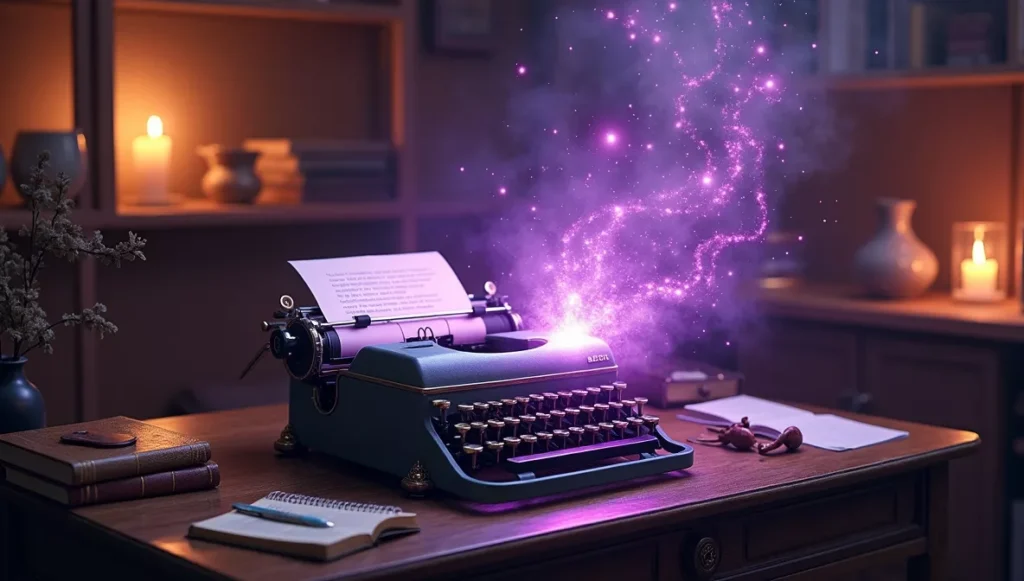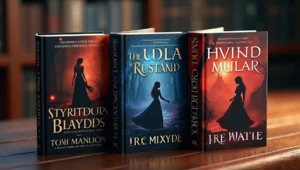Have you ever stared at a blank page, waiting for the perfect words to create a beautiful poem? Or maybe you’ve felt the spark of creativity but couldn’t quite capture it in verse? You’re not alone! Poetry writing can feel magical and frustrating at the same time. But here’s some exciting news: artificial intelligence tools are now here to help you write amazing poetry, whether you’re a beginner or an experienced wordsmith.
- What Is AI Poetry Writing?
- Why Should You Use AI for Poetry Writing?
- 💖 You Might Also Like
- The Best AI Tools for Writing Poetry
- 1. ChatGPT
- ✨ More Stories for You
- 2. Claude
- 3. Jasper AI
- 🌟 Don’t Miss These Posts
- 4. Sudowrite
- 5. Copy.ai
- 6. Rytr
- 7. Writesonic
- 8. Simplified
- 9. Bard (Google)
- 10. Quillbot
- How to Get the Most Out of AI Poetry Tools
- Start with Your Own Ideas
- Be Specific in Your Prompts
- Don’t Accept the First Draft
- Add Your Personal Touch
- Learn from the AI
- Experiment with Different Styles
- Combine Multiple Tools
- Keep a Poetry Journal
- Understanding Different Poetry Forms
- Free Verse
- Haiku
- Sonnet
- Limerick
- Acrostic
- Ballad
- Tips for Different Types of Writers
- For Students
- For Creative Writers
- For Hobbyists and Poetry Lovers
- For Professional Writers
- Common Mistakes to Avoid
- Using AI-Generated Poetry Without Editing
- Making Prompts Too Vague
- Ignoring Your Own Voice
- Not Experimenting Enough
- Forgetting to Learn
- Comparing Yourself to Others
- Ignoring Copyright and Ethics
- The Future of AI Poetry
- Real Success Stories
- Practical Exercises to Try
- Conclusion: Your Poetry Journey Starts Now
Think of AI poetry tools as your creative companions. They’re like having a writing buddy who never gets tired, always has fresh ideas, and can help you explore different styles of poetry you’ve never tried before. In this guide, we’ll explore the best AI tools for writing poetry, how they work, and how you can use them to create beautiful verses that touch people’s hearts.
What Is AI Poetry Writing?
Let’s start with the basics. AI poetry writing means using computer programs that understand language to help you create poems. These programs have read millions of poems, stories, and texts, so they’ve learned patterns in how words flow together, how rhymes work, and what makes language beautiful.
Imagine teaching a robot to paint by showing it thousands of famous paintings. Eventually, that robot would learn about colors, brush strokes, and composition. AI poetry tools work the same way, but with words instead of paint!
The cool thing is that AI doesn’t replace your creativity. Instead, it works alongside you. You bring your emotions, experiences, and unique perspective. The AI brings suggestions, different word choices, and can help when you’re stuck. Together, you create something special.
Why Should You Use AI for Poetry Writing?
Before we dive into the best tools, let’s talk about why AI poetry assistants are becoming so popular among writers, students, and poetry lovers.
Breaking Through Writer’s Block
We’ve all been there. You want to write, but the words just won’t come. AI tools can give you that first line, suggest a theme, or help you continue when you’re stuck. They’re like a gentle push to get your creative wheels turning again.
Learning New Poetry Styles
Want to try writing a haiku but don’t know where to start? Curious about sonnets? AI tools can show you examples, explain the rules, and help you practice different forms. It’s like having a poetry teacher available 24/7.
Expanding Your Vocabulary
💖 You Might Also Like
Sometimes we use the same words over and over. AI can suggest synonyms, related words, and fresh ways to express your ideas. This helps your poetry sound more varied and interesting.
Saving Time
If you’re a student working on a poetry assignment or a writer with a deadline, AI tools can help you work faster. They handle the technical stuff while you focus on the emotional heart of your poem.
Building Confidence
Many people feel scared to write poetry because they think it needs to be “perfect.” AI tools take away that pressure. You can experiment, make mistakes, and try different approaches without judgment.
The Best AI Tools for Writing Poetry
Now let’s explore the top AI tools that can help you write beautiful poetry. Each tool has its own strengths, so you can pick the one that fits your needs best.
1. ChatGPT
ChatGPT is like having a knowledgeable friend who loves poetry and is always ready to help. Created by OpenAI, it’s one of the most popular AI tools available today.
What Makes It Great:
ChatGPT can write poems in almost any style you can imagine. Want a funny limerick about your cat? Done. Need a serious sonnet about nature? No problem. It can write free verse, rhyming couplets, haikus, and everything in between.
But here’s what makes ChatGPT really special: you can have a conversation with it. If you don’t like something in the poem, just tell it to change that part. Want the poem to sound happier or sadder? Just ask. It’s like working with a writing partner who instantly understands what you need.
How to Use It for Poetry:
Start by being specific about what you want. Instead of saying “write a poem,” try “write a 12-line poem about autumn that uses imagery of falling leaves and includes a metaphor about change.” The more details you give, the better the results.
You can also ask ChatGPT to help you improve poems you’ve already written. Paste your poem and ask questions like “Can you suggest stronger verbs?” or “How can I make the ending more powerful?”
Best For:
Students learning about poetry, beginners who want guidance, and anyone who likes to brainstorm ideas through conversation.
✨ More Stories for You
2. Claude
Claude (that’s me!) is another powerful AI assistant that excels at creative writing, including poetry. I’m designed to be helpful, thoughtful, and good at understanding what you’re trying to create.
What Makes It Great:
I can help you write poetry that feels natural and emotionally authentic. I pay attention to rhythm, flow, and making sure words fit together smoothly. I’m also great at explaining poetry concepts if you want to learn while you write.
One thing people appreciate is that I can adapt to your writing style. If you show me a poem you’ve written, I can help you write more poems that sound similar. I’m also good at understanding abstract or complex themes and turning them into poetic language.
How to Use It for Poetry:
Tell me about the emotion or experience you want to capture. Share the mood you’re going for. I work best when I understand not just what you want to write about, but why you want to write about it.
You can also use me to edit and refine your work. I can suggest different word choices, help with rhythm issues, or explain why certain lines might not be working as well as they could.
Best For:
Writers who want thoughtful feedback, people working on more complex or abstract poetry, and those who appreciate detailed explanations.
3. Jasper AI
Jasper AI is a professional writing tool that many content creators use, but it’s also fantastic for poetry.
What Makes It Great:
Jasper has special templates and modes specifically designed for creative writing. It can generate poems quickly and offers various “tones” you can choose from, like romantic, inspirational, or melancholic.
The tool is really good at creating polished, professional-sounding poetry. If you’re working on something you plan to publish or share widely, Jasper can help make sure it sounds refined.
How to Use It for Poetry:
Jasper works with templates and commands. You select what type of poem you want, enter your topic and any keywords, and it generates options for you. You can then pick the best parts from different versions to create your final poem.
🌟 Don’t Miss These Posts
Best For:
Serious hobbyists and professional writers who plan to publish their work, people who want polished results quickly.
4. Sudowrite
Sudowrite is specifically designed for creative writers, and it’s loved by fiction authors and poets alike.
What Makes It Great:
This tool focuses on making your writing more vivid and sensory. It’s excellent at suggesting descriptive language, metaphors, and imagery. When you’re writing poetry that needs to paint pictures in readers’ minds, Sudowrite shines.
The “Rewrite” function is particularly useful. You can highlight a line or stanza you’re not happy with, and Sudowrite will offer multiple alternative ways to express the same idea, often with more poetic language.
How to Use It for Poetry:
Write your poem first, even if it’s rough. Then use Sudowrite to enhance specific parts. Highlight words or phrases and use the “Describe” feature to get more sensory and emotional language. The tool will suggest metaphors and imagery you might not have thought of.
Best For:
Intermediate to advanced writers who want to add more literary depth to their work, poets focused on imagery and sensory details.
5. Copy.ai
Copy.ai started as a marketing tool but has grown into a versatile writing assistant that works wonderfully for poetry too.
What Makes It Great:
This tool is super user-friendly and perfect for beginners. It has a clean, simple interface that doesn’t overwhelm you with options. Copy.ai can generate poems quickly and offers various styles to choose from.
What makes it stand out is how easy it is to generate multiple versions. Not happy with the first poem? Click again and get something completely different. This makes it great for exploring different approaches to the same topic.
How to Use It for Poetry:
Use the “Blog Ideas” or “Creative Story” templates as starting points for poetry. Enter your theme or topic, and let the tool generate ideas. You can then take these ideas and refine them into poetry.
Copy.ai is also great for generating opening lines when you’re stuck. Get a few options, pick the one you like best, and build your poem from there.
Best For:
Absolute beginners, students working on assignments, people who want to quickly generate ideas.
6. Rytr
Rytr is an affordable AI writing tool that punches above its weight when it comes to creative writing.
What Makes It Great:
Rytr offers a forever-free plan, making it accessible to students and hobbyists on a budget. Despite being free, it produces quality poetry and offers multiple tone options.
The tool is straightforward and doesn’t require a learning curve. You can start writing poetry within seconds of signing up.
How to Use It for Poetry:
Select the “Song Lyrics” or “Creative Writing” use case, choose your tone and style, then enter your topic. Rytr will generate content that you can shape into poetry.
The tool works best for shorter poems and can be used multiple times to generate different stanzas that you then combine into a longer piece.
Best For:
Budget-conscious writers, students, people who want a simple tool without complex features.
7. Writesonic
Writesonic is another versatile AI tool with strong poetry-writing capabilities.
What Makes It Great:
This tool offers a good balance between ease of use and powerful features. It can generate poems in various styles and allows you to set the creativity level, which controls how experimental or conventional the output will be.
Writesonic is particularly good at maintaining consistent themes throughout a poem. If you want a poem that stays focused on a single idea or emotion, this tool handles that well.
How to Use It for Poetry:
Use the article writer or blog post features as starting points, then adapt the output into poetry. You can also use the “AI Article Writer” to generate prose about your topic, then use that prose as inspiration for your poem.
Set the creativity level higher for more experimental, unique poetry, or lower for more traditional, accessible verse.
Best For:
Writers who want control over how creative or conventional their poems are, people working on themed poetry collections.
8. Simplified
Simplified is an all-in-one content creation platform that includes AI writing tools perfect for poetry.
What Makes It Great:
Beyond just writing, Simplified offers design tools, so you can create beautiful visual presentations of your poetry. This is perfect if you want to share poems on social media or create poetry posters.
The AI writing assistant is intuitive and offers many templates. The platform encourages experimentation and makes it easy to try different approaches.
How to Use It for Poetry:
Use the writing templates to generate poem drafts, then switch to the design tools to create visual versions. You can add backgrounds, fonts, and images that complement your poetry.
This is particularly useful for Instagram poets or anyone who wants to combine their words with visuals.
Best For:
Social media poets, people who want to create visual poetry, writers who also want design capabilities.
9. Bard (Google)
Google’s Bard is a powerful AI assistant that can help with poetry writing.
What Makes It Great:
Bard is connected to the internet, so it can reference current events and recent information. This makes it great for writing topical poetry about things happening in the world right now.
The tool can also search for poetic techniques and explain them, making it educational as well as creative.
How to Use It for Poetry:
Ask Bard to write poems about current topics or trends. You can also ask it to explain different poetry forms and then help you write in those forms.
Use Bard’s search capabilities to find inspiration. Ask it about poetic traditions from different cultures or time periods, then create poems inspired by what you learn.
Best For:
People writing topical poetry, students researching different poetry traditions, writers who want their AI assistant to have current knowledge.
10. Quillbot
While Quillbot is primarily known as a paraphrasing tool, it’s surprisingly helpful for poetry writing.
What Makes It Great:
Quillbot excels at helping you find different ways to express the same idea. This is incredibly useful in poetry, where word choice is everything.
The synonym tool is particularly strong, helping you find the perfect word with just the right connotation and sound.
How to Use It for Poetry:
Write your poem first, then use Quillbot to explore different word choices. Paste your poem into the tool and use the paraphrase function to see alternative phrasings.
The synonym slider lets you control how different the suggestions are from your original words. This helps you maintain your voice while improving specific lines.
Best For:
Editing and refining existing poems, finding the perfect word choice, poets who have already drafted their work.
How to Get the Most Out of AI Poetry Tools
Now that you know about the best tools, let’s talk about how to use them effectively. These tips will help you create better poetry and develop your skills.
Start with Your Own Ideas
Always begin with your own thoughts, feelings, or experiences. AI tools work best when you give them something to work with. Think about what you want to express before asking the AI for help.
What emotion are you feeling? What story do you want to tell? What image is stuck in your mind? Start there, then use AI to help you express it in poetic language.
Be Specific in Your Prompts
The more details you provide, the better results you’ll get. Instead of “write a love poem,” try “write a 16-line love poem that compares falling in love to discovering a hidden garden, using imagery of flowers and sunlight, with a gentle, hopeful tone.”
Include details about:
- The emotion or mood you want
- The length of the poem
- The style or form (haiku, sonnet, free verse, etc.)
- Any specific images or metaphors you want to include
- The perspective (first person, second person, etc.)
Don’t Accept the First Draft
AI tools generate text quickly, but that first version is rarely the best. Think of it as a rough sketch. Ask the AI to revise, try different approaches, or focus on specific parts that need improvement.
Generate multiple versions and combine the best parts. Take line three from one version, line seven from another, and create something new.
Add Your Personal Touch
This is the most important tip: always edit AI-generated poetry to make it yours. Add your unique voice, change words that don’t feel right, and inject your personal experiences.
AI doesn’t have emotions or experiences. It arranges words based on patterns, but you bring the humanity. Your edits, your choices, and your feelings transform AI suggestions into real poetry.
Learn from the AI
Pay attention to how the AI structures lines, chooses words, and creates metaphors. You can learn a lot about poetry techniques by analyzing what works and what doesn’t in AI-generated poems.
Ask the AI to explain its choices. “Why did you use this metaphor?” or “Can you explain the structure of this poem?” Many AI tools will break down their reasoning, which helps you understand poetry better.
Experiment with Different Styles
Use AI tools to try poetry forms you’ve never attempted. Always wanted to write a villanelle but found it too complicated? Ask the AI to help you understand the form and write one together.
This experimentation helps you grow as a writer and discover new ways to express yourself.
Combine Multiple Tools
Different AI tools have different strengths. You might use ChatGPT to brainstorm ideas, Sudowrite to enhance your imagery, and Quillbot to refine your word choices. Using multiple tools in your creative process can produce amazing results.
Keep a Poetry Journal
Save all your AI-assisted poems, even the ones you don’t love. Over time, you’ll see your progress and might find lines or ideas you want to return to later.
This journal also helps you understand your own poetic voice and preferences. You’ll notice patterns in what you like and what you want to write about.
Understanding Different Poetry Forms
AI tools can help you write in many different poetry forms. Let’s explore some popular ones so you know what to try.
Free Verse
This is poetry without rules about rhyme or rhythm. It’s the most flexible form and great for beginners. Free verse lets you focus on imagery and emotion without worrying about formal structure.
AI tools excel at free verse because they can be creative without following strict patterns. It’s a great place to start your AI poetry journey.
Haiku
Haiku is a Japanese form with three lines and a specific syllable pattern: 5 syllables in the first line, 7 in the second, 5 in the third. Haikus traditionally focus on nature and moments of insight.
AI tools are very good at counting syllables and can generate many haiku options quickly. This is perfect for practicing concise, imagery-focused writing.
Sonnet
Sonnets are 14-line poems with specific rhyme schemes and meter. They’re more challenging but deeply satisfying to write. The most common types are Shakespearean and Petrarchan sonnets.
AI tools can help you understand and follow the complex rules of sonnets while you focus on your message.
Limerick
Limericks are funny five-line poems with a distinctive rhythm and rhyme scheme (AABBA). They’re light, playful, and perfect for humorous topics.
AI tools often do well with limericks because the form is short and has clear rules. They’re fun to experiment with.
Acrostic
In acrostic poems, the first letter of each line spells out a word or phrase. They’re popular with students and make great personalized gifts.
AI tools can easily generate acrostic poems on any topic. They’re simple but can be surprisingly meaningful.
Ballad
Ballads tell stories in verse, often with a musical quality. They usually have quatrains (four-line stanzas) with specific rhyme schemes.
AI tools can help you craft narrative poems that flow well and maintain story structure throughout.
Tips for Different Types of Writers
Different writers have different needs. Here’s advice based on who you are and what you want to achieve.
For Students
If you’re using AI tools for school assignments, here are some important things to remember:
Always check with your teacher about their policy on AI tools. Some teachers encourage their use as learning aids, while others may have restrictions.
Use AI to learn, not just to complete assignments. Ask the AI to explain concepts, show you examples, and help you understand why certain poetic techniques work.
Never submit AI-generated poetry as entirely your own work. Instead, use AI as a starting point, then heavily edit and personalize the content. Your teacher wants to see your voice and creativity.
Think of AI like a tutor who helps you understand and practice, not someone who does your homework for you.
For Creative Writers
If you’re a serious writer looking to improve your craft:
Use AI tools to push past creative blocks and explore new territories. Let them suggest unexpected metaphors or perspectives you hadn’t considered.
Don’t rely on AI for your final drafts. Use these tools for brainstorming, first drafts, and inspiration, but do significant editing yourself.
Experiment with combining AI suggestions with traditional writing methods. Maybe use AI to generate the beginning of a poem, then finish it yourself without assistance.
Study the AI output to understand why certain phrasings work well. This analysis will make you a better writer.
For Hobbyists and Poetry Lovers
If you write poetry for fun and personal expression:
Feel free to play and experiment without pressure. AI tools are perfect for trying styles you’ve never attempted before.
Use AI to create poetry for gifts, social media, or personal journals. There’s no judgment here—just enjoy the creative process.
Share your AI-assisted poems with friends and online communities. Getting feedback helps you grow and connects you with other poetry lovers.
Don’t worry too much about “rules” or being a “real poet.” If you’re creating with words and expressing yourself, you’re a poet.
For Professional Writers
If you’re writing poetry for publication or performance:
Use AI tools in early creative stages, but rely on your own expertise for final versions. Editors and audiences can often tell when something is purely AI-generated.
Think of AI as a creative partner for brainstorming sessions. Generate ideas, explore angles, then use your professional skills to craft the final piece.
Be transparent about your process if asked. Many professional writers openly discuss using AI tools as part of their creative workflow.
Focus on what makes your voice unique. AI can suggest words, but it can’t replicate your specific life experiences and perspective.
Common Mistakes to Avoid
As you start using AI poetry tools, watch out for these common pitfalls:
Using AI-Generated Poetry Without Editing
The biggest mistake is submitting or sharing AI poetry without adding your personal touch. AI-generated content often lacks emotional depth and authentic human experience. Always edit, revise, and personalize.
Making Prompts Too Vague
“Write a poem” gives the AI almost nothing to work with. The result will be generic. Instead, provide rich details about theme, mood, style, and specific elements you want included.
Ignoring Your Own Voice
Don’t let AI completely take over your creative process. Your unique perspective and voice are what make your poetry special. Use AI to enhance your ideas, not replace them.
Not Experimenting Enough
Many people stick with one AI tool and one type of poem. Branch out! Try different tools, experiment with various poetry forms, and explore unexpected topics.
Forgetting to Learn
If you only use AI to generate finished poems without understanding the techniques involved, you won’t grow as a writer. Ask questions, analyze what works, and consciously learn from the process.
Comparing Yourself to Others
Everyone’s creative journey is different. Don’t compare your AI-assisted poems to others’ work. Focus on your own growth and expression.
Ignoring Copyright and Ethics
Be mindful of how you use and share AI-generated content. Some publications have policies about AI content. Always be honest about your process when it matters.
The Future of AI Poetry
AI poetry tools are evolving rapidly. Here’s what the future might hold:
AI will get better at understanding nuance, emotion, and cultural context. Future tools might be able to write in specific poets’ styles or capture very subtle emotional tones.
We’ll likely see more tools that combine text with audio and visual elements, creating multi-sensory poetry experiences.
AI might become better at providing constructive feedback on your poetry, acting more like a real workshop partner who can explain why certain lines work or don’t work.
There will probably be more educational tools that use AI to teach poetry writing, offering personalized lessons based on your skill level and interests.
But here’s what won’t change: the heart of poetry will always be human. AI tools will get more sophisticated, but they’ll remain tools. The emotions, experiences, and unique perspectives that make poetry meaningful will always come from people.
Real Success Stories
Let’s look at how real people are using AI poetry tools successfully:
Sarah, a high school student, was struggling with a poetry assignment about family. She used ChatGPT to explore different metaphors for family relationships. The AI suggested comparing family to a tree with deep roots and spreading branches. Sarah loved this idea and wrote her poem using this metaphor as a foundation. She got an A and discovered she actually enjoyed poetry.
Marcus, a spoken word poet, uses AI tools to generate multiple opening lines for his poems. He creates about 20 options, then chooses the one that resonates most and builds from there. He says AI helps him get past the fear of the blank page and into his creative flow faster.
Elena, a teacher, uses AI poetry tools in her classroom. She has students work with AI to write poems about historical events they’re studying. Students learn about both poetry and history while developing digital literacy skills. The engagement in her class has skyrocketed.
James, who retired last year, discovered AI poetry tools and started writing poems for his grandchildren. He creates personalized poems for their birthdays and special occasions. The combination of AI suggestions and his personal memories creates touching, unique gifts his family treasures.
These stories show that AI poetry tools work for everyone, regardless of age, skill level, or goals.
Practical Exercises to Try
Ready to start using AI poetry tools? Try these exercises:
Exercise 1: The Emotion Poem
Think of a strong emotion you’ve felt recently—joy, sadness, frustration, excitement. Ask your AI tool to write a poem capturing that emotion without naming it. Then edit the poem to include specific details from your personal experience.
Exercise 2: The Style Challenge
Pick a famous poet you admire. Ask the AI to write a poem in their style about a modern topic. Study how the AI captures that poet’s techniques, then try writing your own poem mimicking that style without AI help.
Exercise 3: The Collaboration
Write the first half of a poem yourself. Then ask the AI to complete it. Compare multiple AI completions and choose your favorite, or combine elements from several versions.
Exercise 4: The Form Explorer
Choose a poetry form you’ve never tried—villanelle, sestina, pantoum. Ask the AI to explain the form and write an example. Then work with the AI to write your own poem in that form.
Exercise 5: The Image Generator
Describe a vivid image or scene to the AI and ask it to write a poem focused entirely on sensory details—what you see, hear, smell, taste, and touch. This exercise improves your descriptive skills.
Exercise 6: The Revision Practice
Write a rough poem yourself, then ask the AI to suggest improvements. Compare the AI version with your original and create a third version combining the best of both.
Conclusion: Your Poetry Journey Starts Now
AI poetry tools have opened up exciting new possibilities for everyone who loves words. Whether you’re a student learning about poetry, a creative writer seeking inspiration, or a literary hobbyist exploring new forms, these tools can help you express yourself in beautiful ways.
Remember, AI is your assistant, not your replacement. The best poetry comes from combining AI’s suggestions with your unique human experience, emotions, and perspective. Use these tools to break through creative blocks, learn new techniques, and explore poetic territories you’ve never visited before.
Poetry has been called the language of the soul. It’s how we express our deepest feelings, share our experiences, and connect with others through the power of words. AI tools make this ancient art form more accessible to everyone. You don’t need to be born with a special gift or spend years studying to write meaningful poetry. You just need something to say and the willingness to experiment.
Start today with one of the tools we’ve discussed. Write about something that matters to you. Don’t worry about being perfect. Play with words, try different styles, and enjoy the creative process. Edit what the AI gives you. Add your voice. Make it yours.
Your poetry journey is uniquely yours, but you don’t have to walk it alone. AI tools are ready to walk beside you, offering suggestions, opening doors, and helping you find the words that might otherwise stay hidden in your heart.
The blank page is no longer as scary. The possibilities are endless. Your voice matters. Your stories deserve to be told in beautiful language. And now you have powerful tools to help you share your poetry with the world.
So take a deep breath, open one of these AI tools, and start writing. The world is waiting to hear what you have to say. Your poetry journey begins with a single word. What will yours be?













